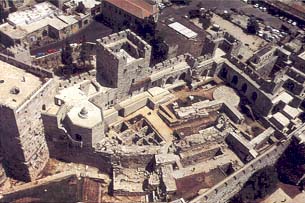Image Details

Zev Radovan
Roman H.Q. When destroying the fortifications of Jerusalem, the Roman general Titus spared three towers built by Herod at this strategic spot (today called David’s Citadel) on Jerusalem’s western hill. Named Phasael (for Herod’s elder brother), Hippicus (after his friend) and Mariamme (for the king’s wife, whom he later murdered), the towers served as headquarters for the Tenth Roman Legion. The remains of Hippicus are today part of David’s Tower (the largest tower in the photo, far left); the two other towers probably lay further to the east.
Many scholars long assumed that the Romans reused these three towers and part of a nearby wall in the fortifications of their camp. The camp wall, they argued, followed the line of a wall that protected Jerusalem in Herod’s time (called the First Wall) and would have run down the center of the courtyard of David’s Citadel (see plan). But excavations inside the courtyard have revealed no remains of a Roman wall.
The Roman-period roof tiles, bricks and other remains discovered inside the Citadel are similar to those found all over the southern part of Jerusalem’s western hill, indicating that the small detachment of Roman soldiers in Jerusalem was probably not based here, but camped in strategic locations all over the hill.
